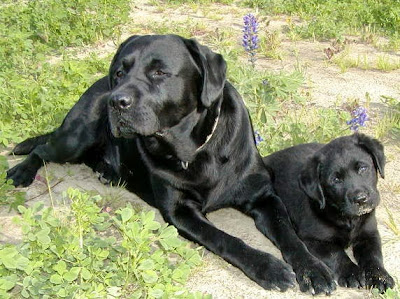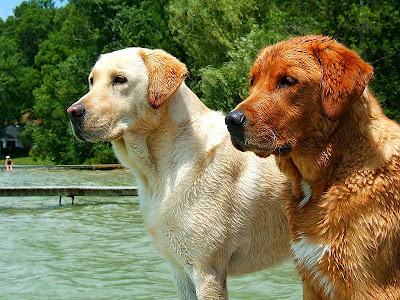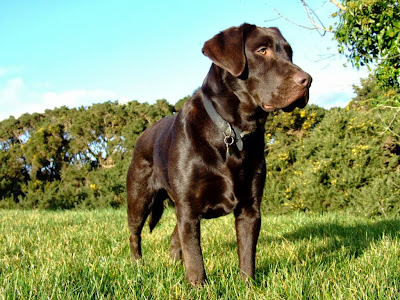As with some other breeds, the Conformation (typically "English", "show" or "bench") and the Field (typically "American" or "working") lines differ, although both lines are bred in both countries. In general, however, Conformation Labradors tend to be bred as medium-sized dogs, shorter and stockier with fuller faces and a slightly calmer nature than their Field counterparts, which are often bred as taller, lighter-framed dogs, with slightly less broad faces and a slightly longer nose; however Field Labradors should still be proportional and fit within AKC standards. With field Labradors, excessively long noses, thin heads, long legs and lanky frames are not considered standard. These two types are informal and not codified or standardised; no distinction is made by the AKC or other kennel clubs, but the two types come from different breeding lines. Australian stock also exists; though not seen in the west, they are common in Asia. These dogs are also very good with children.
The breed tends to shed hair twice annually, or regularly throughout the year in temperate climates.Some Labradors shed considerably; however, individual Labradors vary.Labrador hair is usually fairly short and straight, and the tail quite broad and strong. The webbed toes of the Labrador Retriever make them excellent swimmers. The webbing between their toes can also serve as a "snowshoe" in colder climates and keep snow from balling up between their toes- a condition that can be painful to other breeds with hair between the toes. Their interwoven coat is also relatively waterproof, providing more assistance for swimming.
There is a great deal of variety among Labradors. The following characteristics are typical of the conformation show bred (bench-bred) lines of this breed in the United States, and are based on the AKC standard.Significant differences between UK and US standards are noted.
Size: Labradors are a relatively large breed. They should be as long from the withers to the base of the tail as they are from the floor to the withers. Males should stand 22.5 to 24.5 inches (57 to 62 cm) tall at the withers and weight 65 to 80 lb (29 to 36 kg). Females should stand 21.5 to 23.5 inches (55 to 60 cm) and weigh 55 to 70 lb (25 to 32 kg). By comparison under UK Kennel Club standards, height should be 22 to 22.5 inches (56 to 57 cm) for males, and 21.5 to 22 inches (55 to 56 cm) for females.
Coat: The Lab's coat should be short and dense, but not wiry. The coat is described as 'water-resistant' or more accurately 'water-repellent' so that the dog does not get cold when taking to water in the winter. That means that the dog naturally has a slightly dry, oily coat. Acceptable colours are black, yellow (ranging from ivory or creme to fox red), and chocolate.
Head: The head should be broad with a pronounced stop and slightly pronounced brow. The eyes should be kind and expressive. Appropriate eye colours are brown and hazel. The lining around the eyes should be black. The ears should hang close to the head and are set slightly above the eyes.
Jaws: The jaws should be strong and powerful. The muzzle should be of medium length, and should not be too tapered. The jaws should hang slightly and curve gracefully back.
Body: The body should be strong and muscular with a level top line.
The tail and coat are designated "distinctive [or distinguishing] features" of the Labrador by both the Kennel Club and AKC.The AKC adds that "true Labrador Retriever temperament is as much a hallmark of the breed as the 'otter' tail."
Colour
Labrador Retrievers are registered in three colours:black (a solid black colour), yellow (anything from the colour that some breeders sell as white or cream to "fox-red"), and chocolate (medium to dark brown). Some dogs are sold as "silver" pure-bred Labradors, but purity of those bloodlines is currently under dispute. Major kennel clubs around the world allow Silver Labradors to be registered, but not as 'Silver'. The Kennel Club (England) requires that they be registered as 'Non-recognised'. The parent club for the Labrador Retriever in the USA (the LRC) states publicly that 'There is no genetic basis for the silver gene in Labradors'.Occasionally Labradors will exhibit small amounts of white on their chest, paws or tail, and rarely a purebred Lab will exhibit brindling (stripes) or tan points similar to a Rottweiler.These markings are a disqualification for show dogs but do not have any bearing on the dog's temperament or ability to be a good working or pet dog.
Puppies of all colours can potentially occur in the same litter. Colour is determined primarily by three genes. The first gene (the B locus) determines the density of the coat's eumelanin pigment granules, if that pigment is allowed: dense granules result in a black coat, sparse ones give a chocolate coat. The second (E) locus determines whether the eumelanin is produced at all. A dog with the recessive e allele will produce only phaeomelanin pigment and will be yellow regardless of its genotype at the B locus. The genes known about previously have had their number increased by the introduction of the K locus, where the dominant "black" allele KB is now known to reside.Black or chocolate Labradors therefore must have the KB allele. Yellow Labradors are determined at the E locus, so the K locus is irrelevant in determining their colour. Variations in numerous other genes control the subtler details of the coat's colouration, which in yellow Labradors varies from white to light gold to a fox red. Chocolate and black Labradors' noses will match the coat colour.
According to a 2011 study, 13 out of 245 Labradors studied were heterozygous for the M264V mutation responsible for the melanistic mask, and one was homozygous. Within the breed, this trait is not visible.
Data refer: http://en.wikipedia.org/wiki/Labrador_Retriever









